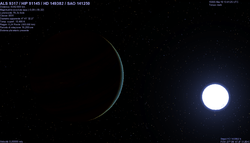HD 149382
 Artist's impression of an unconfirmed brown dwarf HD 149382 b (center) in orbit around the star HD 149382 (right). | |
| Observation data Epoch J2000 Equinox J2000 | |
|---|---|
| Constellation | Ophiuchus |
| Right ascension | 16h 34m 23.33330s[1] |
| Declination | –04° 00′ 52.0171″[1] |
| Apparent magnitude (V) | 8.943[2] |
| Characteristics | |
| Spectral type | B5 VI[3] |
| U−B color index | –1.143[2] |
| B−V color index | –0.282[2] |
| V−R color index | –0.127[2] |
| R−I color index | –0.135[2] |
| Astrometry | |
| Radial velocity (Rv) | +3[4] km/s |
| Proper motion (μ) | RA: –5.95[1] mas/yr Dec.: –3.92[1] mas/yr |
| Parallax (π) | 13.53 ± 1.15[1] mas |
| Distance | 240 ± 20 ly (74 ± 6 pc) |
| Details | |
| Mass | 0.29−0.53[5] M☉ |
| Surface gravity (log g) | 5.80 ± 0.05[5] cgs |
| Temperature | 35,500 ± 500[5] K |
| Metallicity [Fe/H] | −1.30[3] dex |
| Rotational velocity (v sin i) | 4.9 ± 1.4[5] km/s |
| Other designations | |
| Database references | |
| SIMBAD | data |
HD 149382 is a star in the constellation of Ophiuchus with an apparent visual magnitude of 8.943.[2] This is too faint to be seen with the naked eye even under ideal conditions, although it can be viewed with a small telescope.[7] Based upon parallax measurements,[1] this star is located at a distance of about 240 light-years (74 parsecs) from the Earth.
This is the brightest known B-type subdwarf star with a stellar classification of B5 VI. It is generating energy through the thermonuclear fusion of helium at its core.[3] The effective temperature of the star's outer envelope is about 35,500 K, giving it the characteristic blue-white hue of a B-type star. HD 149382 has an optical companion located at an angular separation of 1 arcsecond.[8]
In 2009, a substellar companion, perhaps even a superjovian planet, was announced orbiting the star.[5] This candidate object was estimated to have nearly half the mass of the Sun. In 2011, this discovery was thrown into doubt when an independent team of astronomers were unable to confirm the detection. Their observations rule out a companion with a mass greater than Jupiter orbiting with a period of less than 28 days.[8]
| Companion (in order from star) |
Mass | Semimajor axis (AU) |
Orbital period (days) |
Eccentricity | Inclination | Radius |
|---|---|---|---|---|---|---|
| b | >8-23 MJ | 0.02343 | 2.391 | 0 | 39±13° | — |
See also
References
- 1 2 3 4 5 6 van Leeuwen, F. (November 2007). "Validation of the new Hipparcos reduction". Astronomy and Astrophysics. 474 (2): 653–664. arXiv:0708.1752
 . Bibcode:2007A&A...474..653V. doi:10.1051/0004-6361:20078357.
. Bibcode:2007A&A...474..653V. doi:10.1051/0004-6361:20078357. - 1 2 3 4 5 6 Landolt, Arlo U. (May 2009). "UBVRI Photometric Standard Stars Around the Celestial Equator: Updates and Additions". The Astronomical Journal. 137 (5): 4186–4269. arXiv:0904.0638
 . Bibcode:2009AJ....137.4186L. doi:10.1088/0004-6256/137/5/4186. See table II.
. Bibcode:2009AJ....137.4186L. doi:10.1088/0004-6256/137/5/4186. See table II. - 1 2 3 Cenarro, A. J.; et al. (January 2007). "Medium-resolution Isaac Newton Telescope library of empirical spectra - II. The stellar atmospheric parameters". Monthly Notices of the Royal Astronomical Society. 374 (2): 664–690. arXiv:astro-ph/0611618
 . Bibcode:2007MNRAS.374..664C. doi:10.1111/j.1365-2966.2006.11196.x.
. Bibcode:2007MNRAS.374..664C. doi:10.1111/j.1365-2966.2006.11196.x. - ↑ Wilson, Ralph Elmer (1953). General Catalogue of Stellar Radial Velocities. Washington: Carnegie Institution of Washington. Bibcode:1953GCRV..C......0W.
- 1 2 3 4 5 Geier, S.; et al. (September 2009). "Discovery of a Close Substellar Companion to the Hot Subdwarf Star HD 149382—The Decisive Influence of Substellar Objects on Late Stellar Evolution". The Astrophysical Journal Letters. 702 (1): L96–L99. arXiv:0908.1025
 . Bibcode:2009ApJ...702L..96G. doi:10.1088/0004-637X/702/1/L96.
. Bibcode:2009ApJ...702L..96G. doi:10.1088/0004-637X/702/1/L96. - ↑ "HD 149382 -- Star". SIMBAD. Centre de Données astronomiques de Strasbourg. Retrieved 2010-10-06.
- ↑ Sherrod, P. Clay; Koed, Thomas L. (2003). A Complete Manual of Amateur Astronomy: Tools and Techniques for Astronomical Observations. Astronomy Series. Courier Dover Publications. p. 9. ISBN 0-486-42820-6.
- 1 2 Norris, Jackson M.; et al. (December 2011), "Non-detection of the Putative Substellar Companion to HD 149382", The Astrophysical Journal, 743 (1): 88, arXiv:1110.1384
 , Bibcode:2011ApJ...743...88N, doi:10.1088/0004-637X/743/1/88
, Bibcode:2011ApJ...743...88N, doi:10.1088/0004-637X/743/1/88
External links
- http://exoplanet.eu/planet.php?p1=HD%20149382&p2=b
- http://simbad.u-strasbg.fr/simbad/sim-id?Ident=HD%20149382b
Coordinates: ![]() 16h 34m 23.33330s, −04° 00′ 52.0171″
16h 34m 23.33330s, −04° 00′ 52.0171″